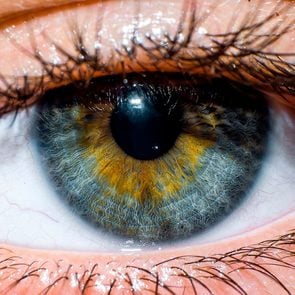Red, itchy eyes are a tell-tale sign of either allergies or pink eye, which can be disconcerting when you’re trying to find the proper remedy to ease the irritation. But before you hit up the pharmacy or schedule an appointment with your doctor, take a look at this guide to help you distinguish the difference between allergies or pink eye.

Pink eye is just a simpler term doctors use with their patients to describe conjunctiva inflammation. Pink eye is otherwise known in the medical world as conjunctivitis. A thin layer, called the conjunctiva, lines the white part of the eye and inside of the eyelid to help keep our eyelids moist, according to the CDC. When the conjunctiva is irritated by allergens or infected by viruses or bacteria, pink eye can ensue. Reddening in the white of the eye, itching, burning and increased tear production are just a few of the pink eye symptoms. But conjunctivitis can manifest itself in many ways, depending on its cause.
Besides, a pink eye diagnosis doesn’t necessarily mean you’re contagious either. Only viral and bacterial infections can cause contagious cases of conjunctivitis. The most common type of pink eye is viral conjunctivitis, which is accompanied by a watery discharge and burning sensation in the eye, according to the American Academy of Ophthalmology. A respiratory infection or cold or flu virus is typically the culprit behind this kind of pink eye. Inflammation usually begins in one eye and potentially spreads to both eyes within days, especially if you use the same hand to rub both your infected eye and uninfected one.
“Someone who has pink eye will usually have a discharge that starts in one eye and spreads to two eyes,” says Wuqaas M. Munir, MD. Dr. Munir is an associate professor of ophthalmology and visual sciences at the University of Maryland School of Medicine. “It feels more irritated like something is in the eye versus an itchy eye for allergies.”
Other than the cause, the key difference between allergies or pink eye is also in the symptoms, particularly the discharge consistency. A thick pus-like discharge that makes your eyes stick together is usually a clear sign of bacterial conjunctivitis. Staphylococcus aureus, the bacteria that causes strep throat, is just one of the many types of bacteria that could infect your eye and lead to bacterial conjunctivitis. (Here’s how to spot the signs of strep throat.) However, you may see little to no discharge in some cases of this type of pink eye.
Unlike the other two types of pink eye, allergic conjunctivitis isn’t contagious and is just your body’s response to allergens like pollen, pet dander, dust mites, and these other surprising triggers of spring allergy symptoms. Your body releases histamine, a chemical that causes inflammation in the body, every time you are exposed to allergens. Thus, the vicious cycle of intense itching, tearing and swelling in both of the eyes begins. “If we look under the eyelid we may find bumps indicative of allergies called papillae,” says Jules Winokur, MD, an ophthalmologist with Lenox Hill Hospital in New York City told Health.com.
Aside from keeping notes of your symptoms, you should also refer to your medical history. If you have seasonal allergies or a recent history of pink eye, that could also help you narrow down the cause. Even asking yourself if you’ve been around anyone with pink eye lately can help. (Find out what it could mean if you have a red spot on your eye.)
Now you don’t need to run off to your doctor’s office at the first sign of red, itchy eyes. Most cases of pink eye are mild and will clear up on their own without treatment or a doctor’s visit. Viral conjunctivitis typically clears up within two weeks. But if you want to speed up the healing process, Dr. Munir says you can “try over-the-counter eye drops and if you’re not better in the first week or two then seek out an eye care professional.” (Check out more ways to treat pink eye symptoms.) If your own remedies aren’t working, your doctor will prescribe you with antibiotics for bacterial conjunctivitis, antiviral medication for viral conjunctivitis, or allergy medications for allergic conjunctivitis. You should also consider seeing your doctor if you experience pain or intense redness in the eyes, light sensitivity, blurred vision or your symptoms worsen with time.
Now that you know how to distinguish between allergies and pink eye, learn to spot the telltale signs of a dangerous eye infection.
Reader’s Digest Canada: Not that long ago, conspiracies were for wing nuts in tinfoil hats. Now they’re everywhere. What happened?
Ghayda Hassan: We’ve definitely seen them gain a lot of momentum in the last few years—the last year, in particular, with COVID-19 and the divisive political climate in the United States. Conspiratorial thinking becomes more popular during times of strife and instability. People are scared and they’re looking for explanations.
What’s the distinction between a conspiracy theory and healthy skepticism?
Broadly speaking, a conspiracy theory is a belief that explains an event or a set of circumstances as the result of a secret plot, usually by a powerful organization. In the case of QAnon, it’s the belief that there’s a secret cabal of Satanist pedophiles running a global child sex-trafficking ring and plotting against Donald Trump.
It’s healthy to question authority, but with conspiratorial thinking you get people ignoring evidence and misinterpreting facts. For instance, Pizzagate—a precursor to QAnon—is the belief that Hillary Clinton’s emails contained codes about a secret child sex ring run out of a pizza restaurant in Washington. It’s true that Clinton did have emails that were under investigation, but that is not evidence of a child sex ring.
It all sounds so preposterous. How do people get sucked in?
Most people don’t wake up one day believing that, for example, the moon landing was staged in a television studio. Instead, it’s more of a grooming process. A person feels dissatisfied or alienated and maybe they watch a video on social media about the landing being a hoax. Certain ideas are normalized, and it’s a slippery slope from there.
A lot of the big conspiracy theories come from the U.S. Are there any that are homegrown?
The Proud Boys, a hate group that made headlines after the storming of the Capitol and uses conspiratorial thinking to push its agenda, was founded by an expat Canadian. But with Canada being a much smaller country, we tend to follow a lot of what we see in the U.S. For example, the armed man who stormed the gates of Rideau Hall was a QAnon supporter.
Are popular conspiracy theories always political?
They often are, but not always. For instance, there’s one that the underwire in bras causes cancer and another that Bill Gates wants to use vaccines to install tracking devices in humans.
Are there characteristics that make a person more likely to fall for them?
There are, but they’re not necessarily what you would think. People have this idea that it’s more common among less educated people, but that’s not really the case. We know that access to broad sources of information is beneficial, which may relate to a person’s level of education, but far more often we see a connection to life events: a job loss, the end of a relationship, a death. These may lead to isolation, and when a person is isolated they become far more susceptible—particularly if they’re spending a lot of time online.
How can you help a loved one to not get caught up in a conspiracy theory?
We want to talk about prevention rather than interruption, because once a person gets entrenched, pulling them out is a lot more complicated. It’s important to understand that you don’t have to debate the conspiracy theory. In fact, that can be counterproductive because it can make the person feel more isolated. The best way to help someone is to address the circumstances that have made that individual vulnerable—checking in on them regularly and encouraging social connections and community ties.
Ghayda Hassan is the director of the Canadian Practitioners Network for the Prevention of Radicalization and Extremist Violence.
My hometown is Dominion City, Manitoba, close to Emerson, a customs-office community on Highway 75, about 12 miles north of the U.S.-Canada border. It was originally called Roseau Crossing, which was similar to other names in the area and so was changed to Dominion City in 1880. I grew up on a farm three miles from town and lived there until 1963.

It has been said that “once you’ve lived in Dominion City, you will never be truly content living elsewhere.” And as the years passed, school reunions were always well attended. We were a variety of nationalities, and we all got along fine. Some of the businesses then included a McCleods store, Sokolyk’s Grocery, a shoe repair shop, Pete’s and Solnes Cafés, a Bank of Commerce, a pharmacy, Mrs. Jones Bakery, Ballasts Garage and The Queen’s Hotel. The RM of Franklin customs office was built in 1945, the Franklin Manor in 1967. There was an elementary school and a high school, and there has always been an arena for as long as I can remember.
Dominion City has always been a very sports-minded community. Sports popular in those days included various kinds of baseball, curling and hockey. They have a golf course, now, as well as an Olympic-sized, heated swimming pool, where many children take swimming lessons every summer.
In 1950, there was a very serious flood; water completely inundated the town and isolated the community from the outside world.
The Red Cross dropped off parcels of food and clothing by plane. My parents, Arthur and Kathleen Knutson, were married in 1949. I remember Mom telling me that the only things not under water were the house and the long driveway. They’d have to leave Dad’s new truck parked on the road and walk to the house together without stopping until they got to the door because the muck and mire seemed determined to suck the boots right off their feet. What a preparation for marriage!

I remember one Halloween some of the high school guys put an outhouse at the top of the front entrance to the high school, then backed a truck up to the other entrance, and let loose a load of chickens and turkeys into the basement. It took them most of the morning to clean it all up!
4H was always an important activity throughout the year. On “Field Day,” they usually had a booth and gave presentations on different topics. One year, we had an actual soldier teach us the proper way to march!
Check out more hidden gems from across Canada.

For the past two years, I have had the privilege of witnessing two families of pileated woodpeckers build their nests and fledge two sets of nestling pileated chicks.
It began while I was out looking for something to photograph just north of my home here in Blind River, Ontario. Driving along a country road, I noticed a huge pileated woodpecker flying towards my car, when it suddenly vanished.
I turned around to look for the spot the woodpecker had landed and caught sight of a telephone pole with a huge hole in it. I pulled over and noticed a female pileated woodpecker poke her head out of the opening, sending woodchips falling from the newly excavated hole.

Pileated woodpecker facts
I have since learned a few interesting pileated woodpecker facts. The male and female take turns digging out the hole, with the male doing most of the excavating. The entrance of the hole is usually about nine centimetres in diameter, with the depth of the cavity being between 25 to 60 centimetres deep. The nesting cavity takes from six to seven weeks to complete before the female lays between three and five eggs.
The eggs will be incubated for just over two weeks, while both parents take turns incubating them. Both the male and female will take turns feeding the chicks. For both years that we observed them, these woodpeckers had three chicks, two male and one female. You have to be around the cavity when the chicks fledge because they exit the hole so fast—you need to spend the entire day waiting to see this event happen. Unfortunately for us, we missed it both times!
The main diet of the pileated chicks are carpenter ants, but they will also eat beetle larvae, along with berries and nuts.
The parents collect carpenter ants from old decaying wood in the forest, swallow the ants and regurgitate them to feed the always hungry chicks. After about a month, the young will leave the nest. The chicks will stay with the parents until fall, then they will strike out and find their own territories. A pileated woodpecker’s territory can encompass more than 600,000 square metres (150 acres).

The difference between a male and female is that the male has a full red crest and a red stripe below its bill, while the female has a partial red crest and a black stripe below its bill. The pileated woodpecker is the largest North American woodpecker still in existence and can reach a length of about 46 centimetres. The ivory-billed woodpecker is actually the largest but is considered extinct.
Pileated woodpeckers bond for life and stay together all year long. They only use each tree cavity once, but the vacated holes are often later taken over by boreal owls, wood ducks, pine martens and kestrels. We noticed that last year’s cavity was used by American kestrels, where they raised their own brood.
As big as they are, the pileated woodpeckers do have predators, including black snakes, cooper hawks, northern goshawks, red-tailed hawks, great horned owls and squirrels.
There are a lot of pileated woodpeckers here in Blind River, evidenced by the many tress with huge holes in them—they truly are nature’s carpenters.
If you enjoyed these pileated woodpecker facts, you won’t want to miss this gorgeous gallery of Canadian bird photography.











